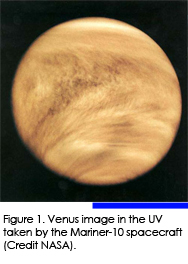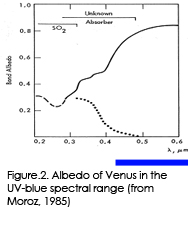
In the visible spectral range Venus appears from space as a featureless yellowish disc. The ubiquitously present cloud veil completely hides the surface that makes the planet a very specific object for imaging. Early observations demonstrated efficiency of imaging at Venus, especially in the UV-blue spectral region in which the Venus spectrum shows broad absorption feature in the 0.25-0.5 µm range. Strong absorption below 0.32 µm is explained by the presence of SO2 gas at the cloud tops. Spectral dependence of Venus albedo between 0.32 µm and 0.5 µm indicates another absorber which composition and nature has not been identified so far. Its identification is important because this specie absorbs about 50% of solar radiation that Venus receives from the Sun. This has implications for the energy balance and dynamics of the entire atmosphere. Early observations showed that the unknown absorber is located in a few kilometer thick layer within the upper cloud deck. The UV markings observed on the Venus disc are produced by variations of its amount and overlying haze opacity.
The VMC UV filter is centered at 365 nm – the region of specific spectral feature of the unknown absorber and maximum contrast observed on the Venus disc. The camera will continue the Pioneer Venus investigations of distribution and variability of the UV absorber by observing the contrasts and their dependence on phase angle. Combination with the VIRTIS measurements in the near-infrared absorption bands of CO2 will help to constrain the altitude of formation of bright and dark features and location of the absorber within the cloud deck. Combination of the VMC imaging and VIRTIS spectroscopy in the UV range will also allow one to study correlation of the unknown absorber with sulfur dioxide that would give a hint on the origin of the unknown specie.

